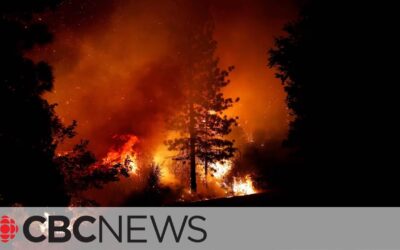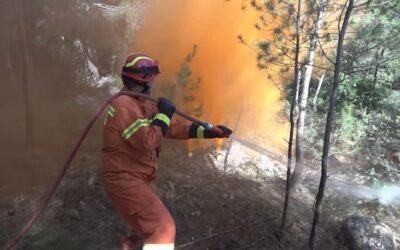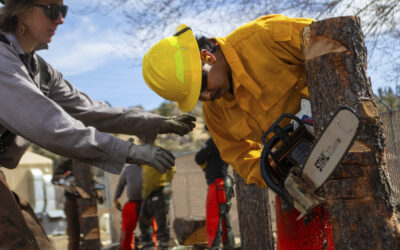The application and tactical benefits of rotor-wing and fixed-wing aircraft
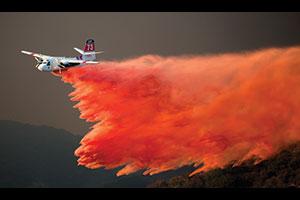
Fixed-wing aircraft is responsible for the most impact on large, fast-moving fire fronts. (Photo by John Cetrino.)
TODD MCNEAL | From the April 2016 Issue of FireRescue Magazine
As the wildland fire conditions continue to increase in intensity each year throughout the West, wildland firefighters have to react with improved tactics and a rapid response with both ground and air assets. As I watched the 2015 fire season unfold, it became apparent that air resources were vital in the combat of the rapid fire growth and the most problematic result of extreme fire behavior-long-range spotting. All wildland firefighters responding to an expanding incident need to be knowledgeable of aerial firefighting tactics and proficient at working with the air resources to maximize their effectiveness. Like most technology in our modern word, the aerial firefighting resources of this country are becoming more diverse and constantly improving. Their ability to maneuver, drop precisely, provide remote intelligence, and deliver more suppression agent has never been greater. However, despite all of these and numerous other technological advancements, the need to work in conjunction with ground resources has not and will never change.
As our world witnessed this past fire season, the resultant fire behavior produced by the drought-stricken West was staggering. The loss of life and property was record setting and the statistics of acres consumed and dollars spent were also. When fire conditions reach such an aggressive and dangerous state, the ability to attack solely on the ground is ineffective and hazardous. The only way to help slow progress and defend values at risk is the fleet of aircraft. Both rotor-wing and fixed-wing have their advantages and disadvantages under certain conditions, and both aircraft type require different tactical application and response from ground resources. Wildland firefighters in any sort of command function on a rapidly expanding wildland fire must have a strong working knowledge of the application and tactical benefits of each aircraft class and type.
Rotor-Wing Aircraft
This class of aircraft is the most versatile used in wildland incident management. Helicopters are the backbone of suppression and logistical missions and support ground resources in many ways. From troop shuttles to gear hauling to water dropping, these are used successfully every summer flying thousands of hours. For the sake of brevity, I will not list all of the advantages or disadvantages in every possible situation, but I would like to touch on the fundamental considerations when working with helicopters.
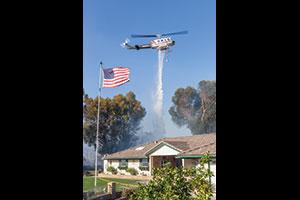
Rotor-wing aircraft are the most versatile used in wildland incident management. (Photo by Tod Sudmeier.)
First and foremost: Always request use of helicopters through the air tactical group supervisor (ATGS) or helicopter coordinator (HLCO). These individuals are the aerial supervisors over the incident and directly manage the airspace and maintain vigilant accountability for all the aircraft working over the fire. These supervisors are juggling all of the mission requests from the incident management team but also the daily suppression resources and need to be notified of the request to track and ensure all objectives for that operational period are being addressed. This request may be routed through the division/group supervisor (DIVS) you are working for or may come directly from you to ATGS depending on the DIVS management preference. Regardless, this has to be done over the air tactics frequency assigned to the incident and is now more commonly done over the air-to-ground command channel because of the complexity of the incidents and the volume of radio traffic related to working with the various aircraft over the fire.
When requesting helicopter resources, please make sure that you have a specific location for the helicopter to report to; this could be a global positioning system (GPS) coordinate or a general location identified on the daily fire map like a drop point or topographic feature identified within a division. If you choose to use GPS, please ensure that the coordinates are given in the format of degrees and decimal minutes. This display format is the default used by aircraft working over wildland incidents and is how their GPS is set. An example of this format reads like this: 38 2.335’ N by 120 13.675’ W.
In addition to having a concise location of the mission, one must have prepared a clear and concise mission objective or target and a ground contact who the inbound helicopter can hail when approaching the target area. The radio traffic between the assigned helicopter and the ground contact must be conducted on the appropriate assigned air-to-ground tactical frequency that you made the request for aircraft on. The single most frequent oversight I have witnessed while working aircraft on wildland incidents is the identified ground contact does not respond promptly to the inbound helicopter. This is frustrating for all parties and ultimately dangerous for the pilot with exposure to the unnecessary flying in circles trying to raise a contact on the radio. If you are the ground contact, please take your radio off “scan†and be on the correct channel.
Once you have established contact with an inbound helicopter, ensure that the pilot has a clear understanding of your location and the target location in reference to your position. This verbal description can most easily be accomplished by talking in terms of clock dial direction from the pilot’s position (not yours). You would absolutely not use your clock directions because the pilot doesn’t yet know where you are; you should also not use vague descriptions like: “I am the person with a yellow helmet next to the large pine tree.â€
Protocol suggests that you give a clock direction from the pilot’s perspective to your location and then add an adjective of high, level, or low. This is critical information for the pilot to be able to look in a specific direction and wait for additional visual clues to your location. The additional clues from you should most typically be in the form of a mirror flash or a bright panel you have placed near you or the target.
Once the pilot has a reference location for you, the next transmission should be to describe the target location and desired action of the helicopter in terms of a unit of measure that they are intimately familiar with: rotor widths. Once the target has been described and the mission completed, give feedback to the pilot, especially if you have additional needs or, for example, want to correct the placement of the water drop that just was completed. If you have no additional needs, make sure the pilot understands that you have released that ship back to the ATGS for reassignment.
Another very important safety issue to remember around the larger helicopters is the significant rotor wash that comes down out of their rotor and the subsequent impact on the fire behavior and the vegetation. Please ensure as the ground contact working with a type one helicopter that you can positively confirm with the pilot that all ground resources are out of the target area.
Fixed-Wing Aircraft
This class of aircraft is responsible for the most impact on large, fast-moving fire fronts. They can be used in an offensive or direct suppression mode or in an indirect mode. Fire behavior explodes when conditions are in alignment, and when that occurs there is little ground or air resources can do to stop perimeter growth and spotting.
Point-protection of certain values at risk can be accomplished but often the greater perimeter continues to grow until conditions producing the extreme behavior abate. These conditions are when the fixed-wing aircraft are exceptionally beneficial to assist in dropping out in front of the fire front to slow its progress, giving ground resources time to construct an indirect containment line. Once the line has been built, it is once again the fixed-wing aircraft that are often used to pretreat the “green side†of the containment line in anticipation of firing operations.
One difference between the requesting paths for fixed-wing vs. rotor-wing aircraft is that mission requests for fixed wing or “air tankers†are not typically generated by the field personnel. These resources are usually coordinated at the operation section chief (OSC) and air operation branch director (AOBD) level. The AOBD works directly with the incident commander and the operations section and through the ATGS to prioritize the targets and missions for the large fixed wing. An exception to this might be during the initial attack phase or when division-level resources are using the smallest fixed-wing aircraft, called single engine air tankers or SEATs.
Despite the fact that requests and coordination are handled at higher levels in the incident management organization, the ground level personnel must be aware and mindful of the activities of the large aircraft, especially if they are working in your assigned area. These machines are dumping enormous amounts of retardant that weighs close to 10 pounds per gallon and comes in drops at times of more than 10,000 gallons. This fact means the path of retardant must be clear of personnel and equipment and must be confirmed by the pilots of both the delivery aircraft and the lead plane. The lead plane is responsible for communication verbally and by demonstration to the Type 1 tankers and the very large air tankers (VLATs-those carrying more than 8,000 gallons) the line to fly and when to drop the product. Ground personnel supervisors would be well advised to listen to the air-to-ground command channel and watch for the lead plane making its first pass with a tanker in tow. This is the called the dry run and the next pass will be live-you do not want to be under it. Remember that if you or you crew are not able to get out of the drop zone, lay flat on the ground away from aerial hazards with your head toward the approaching drop with one hand holding your helmet and the other outstretched and firmly grasping your hand tool.
Air and Ground
Aerial resources are quite effective in suppressing the advancement of wildland fire, but it is the boots on the ground that will ultimately stop the fire by securing the edge. One last thought: If you park your vehicle and are out on foot for any reason, be mindful of aircraft of any type working overhead. Never underestimate the length of the retardant drop or you may return to your vehicle with a new paint job.
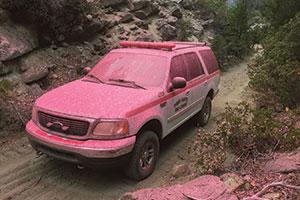
Never underestimate the length of the retardant drop or you may return to your vehicle with a new paint job. (Photo by author.)
 Todd McNeal is a 23-year veteran of the fire service and chief of Twain Harte Fire in Tuolumne County, California. He has a diverse background in wildland and structural fire management and suppression and has been serving as a division/group supervisor on a Federal Type II Incident Management Team for 10 years. McNeal has been an instructor in the fire service for 15 years, holds numerous ICS qualifications in wildland operations, is a registered instructor with California State Fire Training and a California fire officer, and has a bachelor’s degree in natural resource management
Todd McNeal is a 23-year veteran of the fire service and chief of Twain Harte Fire in Tuolumne County, California. He has a diverse background in wildland and structural fire management and suppression and has been serving as a division/group supervisor on a Federal Type II Incident Management Team for 10 years. McNeal has been an instructor in the fire service for 15 years, holds numerous ICS qualifications in wildland operations, is a registered instructor with California State Fire Training and a California fire officer, and has a bachelor’s degree in natural resource management

